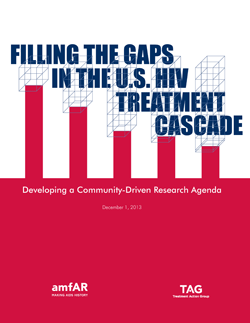December 1, 2013
By David Barr
INTRODUCTION
Since the introduction of highly active antiretroviral therapy (ART) in 1996, the annual death rate from HIV/AIDS has dropped in the United States by over two-thirds. The U.S. Centers for Disease Control and Prevention estimates that approximately 1.2 million Americans are living with HIV. More recent data indicate that ART not only prevents progression to AIDS and death, but, when used among serodiscordant heterosexual couples earlier, ART also reduces HIV transmission by 96 percent. The enactment of the Affordable Care Act and related expansion of Medicaid will ensure access to health care for millions of Americans living with and at risk for HIV disease. The National HIV/AIDS Strategy, issued in 2010, articulates the government’s commitment to addressing the HIV epidemic, and the Obama administration has made ending AIDS a priority both in the United States and around the world.
However, despite these advances, there are approximately 56,000 new HIV infections and over 8,000 AIDS deaths each year in the United States. The racial disparities seen generally in health outcomes are prevalent in HIV. African Americans accounted for 44 percent of new HIV infections diagnosed in 2009, although they constitute only 14 percent of the population. HIV also disproportionately affects people living in southern states, the states least likely to implement Medicaid expansion where the need is greatest. Ending AIDS in America will take continued advocacy, commitment, and political will.
Changes in health care delivery mechanisms and scientific advances offer real potential to improve the lives of people living with HIV and to reduce infection rates. The possibility of ending the AIDS epidemic in the United States is real. The tools to do so are now within our grasp. But there is still much to do and to learn in order to use these tools effectively. Information about effective methods to improve delivery of HIV treatment and prevention services has not been adequately disseminated and put into practice. And many key questions about how to best provide those services remain unanswered. The development of a new implementation agenda—one that will chart the course for effective HIV treatment and prevention services—is the next essential step toward realizing a United States, and eventually a world, without AIDS.
At the core of this agenda are people living with HIV and those who are most at risk of infection. The communities affected by HIV must take the lead in articulating their needs and priorities in order for health and social services to be effective. To this end, Treatment Action Group (TAG) and the Foundation for AIDS Research (amfAR) sponsored a workshop in Washington, D.C., on June 18–19, 2013, to develop a community-based agenda to improve implementation of effective service-delivery approaches and identify research priorities for improved management of HIV treatment and prevention, with a particular focus on filling the gaps in the United States HIV continuum of care (or treatment cascade). This document represents the outcomes from that meeting, attended by representatives from government, academia, and health care systems, along with community-based advocates and service providers.
The meeting agenda was structured around the HIV treatment cascade, with the primary focus on linkage to and retention in care. However, participants also discussed how other factors affect linkage to and retention in care, including HIV prevention and testing, racial disparities in health outcomes, community mobilization, and the impact on HIV care of the implementation of the Affordable Care Act (ACA) and other changes in health care infrastructure. The document provides recommendations and priorities for follow-up.

